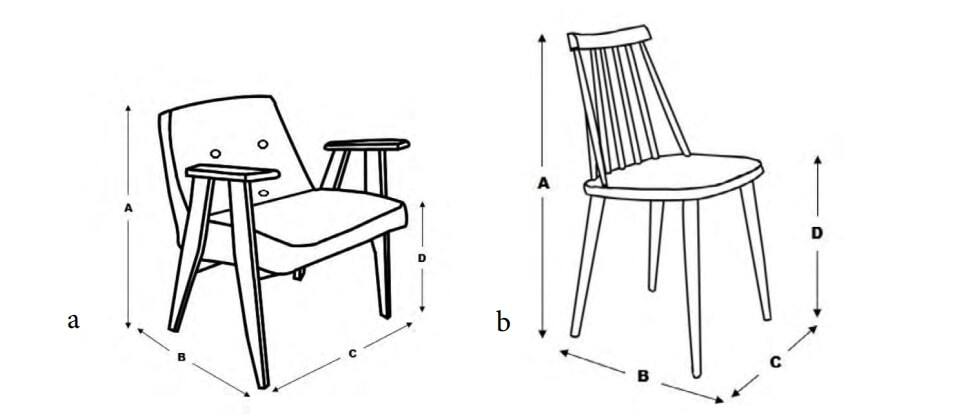Archive
Online first
Current issue
Instructions for Authors
Guide for authors
Peer Review Policy
Research Ethics Policy
Crossmark Policy
Ghostwriting and Guest Authorship
Copyright
Open Access Policy
Plagiarism
About the Journal
Aim and Scope
Scientific Board
Publisher
Editorial Board
Indexing in databases
Personal Data Protection
Repository policy
Contact
ORIGINAL PAPER
Dimensional analysis of seating furniture from the 1960s and 1970s intended for redesign
1
Department of Furniture Design, Poznan University of Life Sciences, Poland
Submission date: 2024-06-10
Final revision date: 2025-01-27
Acceptance date: 2025-02-06
Online publication date: 2025-04-11
Corresponding author
Julia Lange
Department of Furniture Design, Poznan University of Life Sciences, Wojska Polskiego, 60-627, Poznań, Poland
Department of Furniture Design, Poznan University of Life Sciences, Wojska Polskiego, 60-627, Poznań, Poland
Drewno 2025;68(215)
KEYWORDS
TOPICS
wood mechanical and chemical technology, inter alia, sawmilling, composite wood products, wooden construction, furniture making, wood pulp, paper makingenvironmental protection, safety of the processes, products and working stationsother
ABSTRACT
Furniture is an object that accompanies us in everyday life. Therefore, it is important to choose appropriate dimensions, tailored to the human body, which will ensure comfort during use. In this study, the dimensions of seating furniture from the 1960s and 1970s were analyzed from an ergonomic perspective. The chosen period of furniture creation is not accidental, as it has been observed that furniture from this era is often renovated or redesigned. They are not only found in homes but also in public spaces such as cafes, schools, and cultural venues. Based on gathered literature, specific specimens were described and served as the basis for further research. Ten armchairs and twelve chairs were measured, and the obtained dimensions were analyzed. The results were compared with guidelines characterizing ergonomic seating. Additionally, percentile models for sitting positions were analyzed, leading to conclusions. After conducting research and analyzing the dimensions of chairs and armchairs from the 1960s and 1970s, it was found that the overall dimensions and important functional measurements for ergonomic seating deviate significantly from the applicable standards.
REFERENCES (24)
1.
Abdoli Eramaki M. [Ergonomics]. Tehran: OmidMajdPublisher; 1994. p. 275–305. Persian.
2.
Agha SR, Alnahhal MJ. Neural network and multiple linear regression to predict school children dimensions for ergonomic school furniture design. Appl Ergon. 2012;43(6):979–84. doi:10.1016/j.apergo.2012.01.007. [PubMed: 22365329].
3.
Bayatkashkoli A, Nazerian M. [Determination of proper college student chair dimension and comparison with the prevalent model]. Iran JWood Pap Sci Res. 2012;26:772–84. Persian.
4.
Dianat I, Karimi MA, Asl Hashemi A, Bahrampour S. Classroom furniture and anthropometric characteristics of Iranian high school students: Proposed dimensions based on anthropometric data. Appl Ergon. 2013;44(1):101–8. doi: 10.1016/j.apergo.2012.05.004. [PubMed:22695080].
6.
Falahati M, Zokaei M, Sadeghi Naeini H, Moradi GR. [Determination of variables and anthropometric indicators for classroom chair design (Study group: Tehran University Medicine Science–2011)]. Iran Occup Health. 2013;10(2):99–108. Persian.
7.
Gedliczka A. Atlas miar człowieka. Dane do projektowania i oceny ergonomicznej. Centralny Instytut Ochrony Pracy 2001. Warszawa.
8.
Gouvali MK, Boudolos K. Match between school furniture dimensions and children’s anthropometry. Appl Ergon. 2006;37(6):765–73. doi: 10.1016/j.apergo.2005.11.009. [PubMed: 16442494].
9.
Hübner – Wojciechowska J. (2014): Lata 60. XX wieku. Sztuka użytkowa. Przewodnik dla kolekcjonerów. Arkady, Warszawa.
10.
ISO 9241 Ergonomic requirements for office work with visual display terminals (VDTs).
11.
Kashif M, Bhattacharya A, Banerjee D. Design of adjustable desks and chairs for university classrooms suitable for students of Jadavpur University, India. Ergon Rural Dev. 2015:238–43.
12.
Meifeng H., Wenbin H. (2008): A study on composite honeycomb sandwich panel structure. Materials and Design 29: 709-713.
13.
Mokdad M, Al-Ansari M. Anthropometrics for the design of Bahraini school furniture. Int JInd Ergon. 2009;39(5):728–35. doi:10.1016/j.ergon.2009.02.006.
14.
Musa A. Anthropometric evaluations and assessment of school furniture design in Nigeria: A case study of secondary schools in rural area of Odeda, Nigeria. Int J Ind Eng Comp. 2011;2(3):499–508. doi:10.5267/j.ijiec.2011.03.006.
15.
Oyewole SA, Haight JM, Freivalds A. The ergonomic design of classroom furniture/computer work station for first graders in the elementary school. Int J Ind Ergon. 2010;40(4):437–47. doi: 10.1016/j.ergon.2010.02.002.
16.
Panagiotopoulou G, Christoulas K, Papanckolaou A, Mandroukas K. Classroom furniture dimensions and anthropometric measures in primary school. Appl Ergon. 2004;35(2):121–8. doi: 10.1016/j.apergo.2003.11.002.
17.
PN-F-06027-03:1991 – Meble mieszkaniowe – Meble do siedzenia – Podstawowe wymiary funkcjonalne.
18.
Samira Ansari, Ahmad Nikpay and Sakineh Varmazyar 201.8 Design and Development of an Ergonomic Chair for Students in Educational Settings.
19.
Silvana Application of Anthropometry Methods in Ergonomic Chair Redesign to Prevent Fatigue: A Case Study UKM Lestari Jaya, Tulungagung, IOP Conference Series: Materials Science and Engineering, 2021 doi 10.1088/1757-899x/1071/1/012003 issn 1757-8981.
20.
Smardzewski J. (2015): Furniture design. Springer International Publishing, Heidelberg, New York, Dordrecht, London.
21.
Smardzewski J. (2010): Niektóre biomechaniczne aspekty w projektowaniu mebli do wypoczynku i snu. Prace i materiały IWP nr 23. Instytut Wzornictwa Przemysłowego. Warszawa.
22.
Taifa IW, Desai DA. Anthropometric measurements for ergonomic design of students’ furniture in India. Eng SciTech Int J. 2017;20(1):232–9. doi: 10.1016/j.jestch.2016.08.004.
23.
Thariq MM, Munasinghe H, Abeysekara J. Designing chairs with mounted desktop for university students: Ergonomics and comfort. Int J Ind Ergonom. 2010;40(1):8–18. doi: 10.1016/j.ergon.2009.10.003.
24.
Voth C., Yamada V. (2010): Sustainable Lightweight Wood-Strand Panels for Building Construction. Proceedings of the International Convention of Society of Wood Science and Technology and United Nations Economic Commission for Europe – Timber Committee. October 11-14, Geneva, Switzerland, 1-7.
We process personal data collected when visiting the website. The function of obtaining information about users and their behavior is carried out by voluntarily entered information in forms and saving cookies in end devices. Data, including cookies, are used to provide services, improve the user experience and to analyze the traffic in accordance with the Privacy policy. Data are also collected and processed by Google Analytics tool (more).
You can change cookies settings in your browser. Restricted use of cookies in the browser configuration may affect some functionalities of the website.
You can change cookies settings in your browser. Restricted use of cookies in the browser configuration may affect some functionalities of the website.



